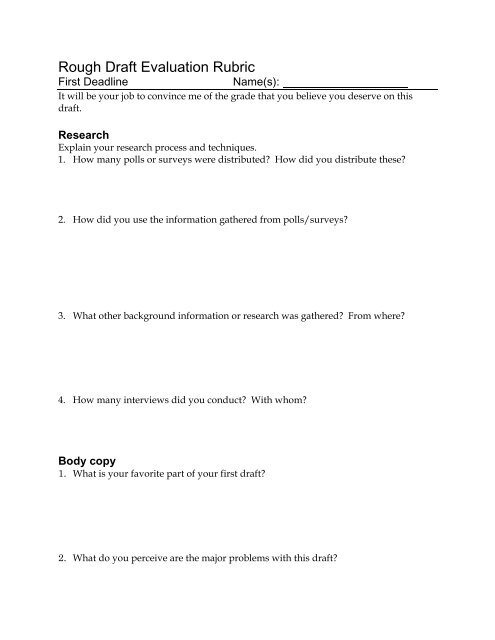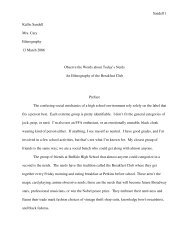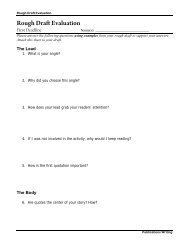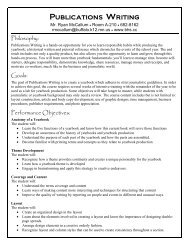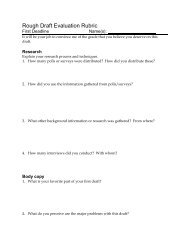You also want an ePaper? Increase the reach of your titles
YUMPU automatically turns print PDFs into web optimized ePapers that Google loves.
<strong>Rough</strong> <strong>Draft</strong> <strong>Evaluation</strong> <strong>Rubric</strong><br />
First Deadline<br />
Name(s):<br />
It will be your job to convince me of the grade that you believe you deserve on this<br />
draft.<br />
Research<br />
Explain your research process and techniques.<br />
1. How many polls or surveys were distributed How did you distribute these<br />
2. How did you use the information gathered from polls/surveys<br />
3. What other background information or research was gathered From where<br />
4. How many interviews did you conduct With whom<br />
Body copy<br />
1. What is your favorite part of your first draft<br />
2. What do you perceive are the major problems with this draft
3. What steps can you take to eliminate or fix these problems as you begin work on<br />
your final draft’<br />
4. What is your story’s angle<br />
5. Why did you pick this angle<br />
6. How do you effectively communicate this angle to your reader early in your story<br />
7. In the space below, write your favorite sentence from your story.<br />
8. Now write your least favorite, or most unclear sentence from your story.<br />
9. Although this draft should not be perfect, how does it represent your best work<br />
10. What is your goal for the rest of the deadline
<strong>Rough</strong> <strong>Draft</strong> <strong>Evaluation</strong><br />
Deadline ____<br />
Moniker(s):____________________________<br />
Before turning in your rough draft, please complete the following rubric. Use this<br />
rubric as you create your draft to help you understand what makes up a quality<br />
yearbook story. I understand that rough drafts do not need to be perfect, but<br />
that doesn’t mean they shouldn’t reflect significant time and effort. Your rough<br />
draft should be “A work” which is still a few steps below “publishable work.”<br />
4 = Exemplary 3 = Very well done 2 = Basic 1 = Not attempted<br />
Student Criteria Teacher<br />
Yes / No<br />
The draft is typed, double-spaced, of correct length (300-350<br />
words for most stories, fewer for Mini Mag)<br />
Yes / No<br />
4 3 2 1<br />
4 3 2 1<br />
4 3 2 1<br />
4 3 2 1<br />
4 3 2 1<br />
There is a clear, unique angle that is made apparent early on<br />
in the story (within the first two paragraphs) and continued 4 3 2 1<br />
throughout the story.<br />
There is a thoughtful, solid, and creative lead. The terms<br />
“Buffalo High School” and “This year” are not present. The 4 3 2 1<br />
lead grabs the reader’s attention, even if he or she is not<br />
involved in the activity.<br />
The body of the story is developed (following T-Q format),<br />
including quotes from new sources (not on the hit list), and 4 3 2 1<br />
does not contain “be verbs” or other weak language.<br />
A variety of sources are used in the story. Story-telling<br />
quotes are the highlight of the story and background 4 3 2 1<br />
information is paraphrased instead of used in direct quotes.<br />
There is an obvious conclusion or a quote that clearly<br />
functions as a conclusion at the end of the story 4 3 2 1<br />
Yes / No<br />
The draft is turned in on time (ready at the start of class), this<br />
rubric is complete, and the rough draft evaluation is done.<br />
Yes / No<br />
4 = Exemplary 3 = Very well done 2 = Basic 1 = Not attempted<br />
Comments:


